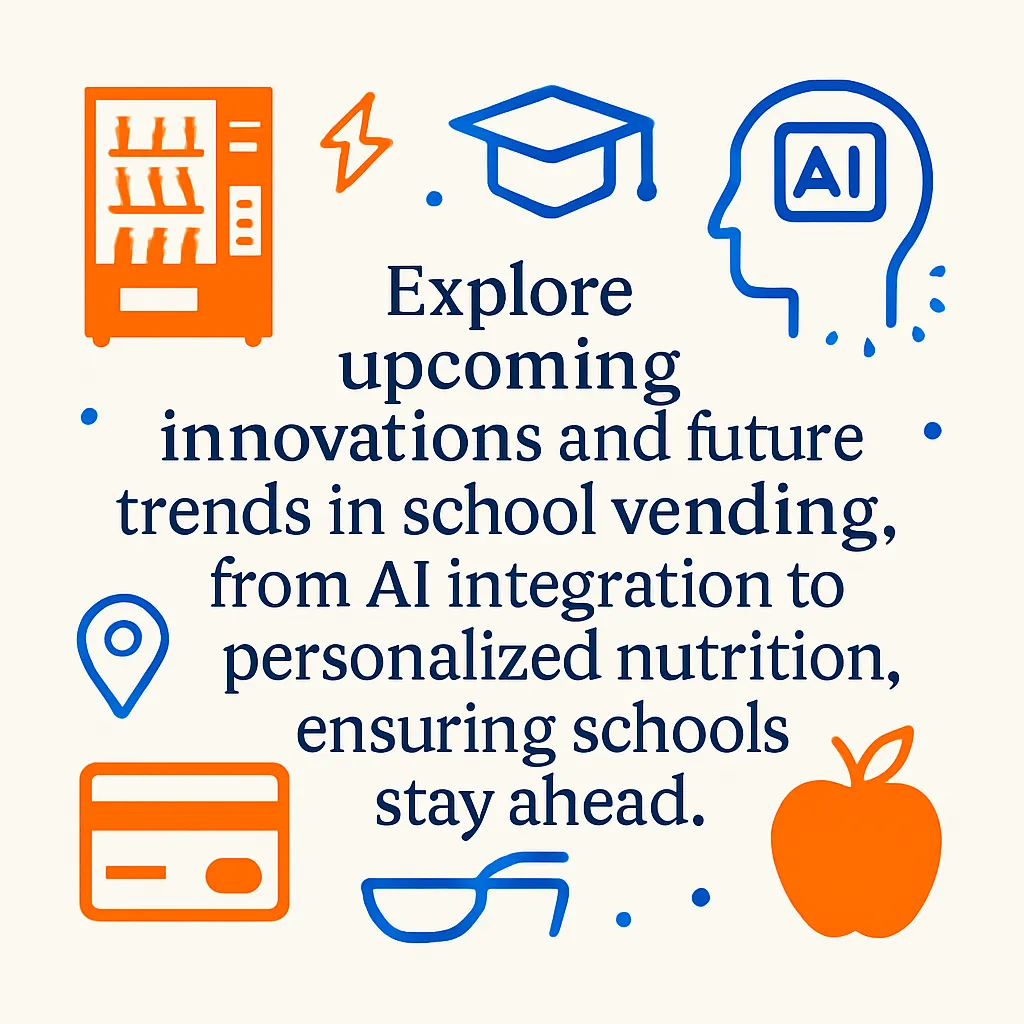Future of School Vending: Trends and Innovations
Explore upcoming innovations and future trends in school vending, from AI integration to personalized nutrition, ensuring schools stay ahead.
Back to Vending for Schools ResourcesExplore upcoming innovations and future trends in school vending, from AI integration to personalized nutrition, ensuring schools stay ahead.
Back to Vending for Schools ResourcesThe landscape of school vending is rapidly evolving, driven by technological advancements and a growing emphasis on student wellness. From smart systems to diverse product offerings, vending machines are poised to become an integral part of modern educational environments.
![]() AI-powered tracking for optimal product freshness and availability
AI-powered tracking for optimal product freshness and availability
![]() Expanded healthy and allergen-friendly options meeting diverse student needs
Expanded healthy and allergen-friendly options meeting diverse student needs
![]() Seamless cashless payment solutions for quick and hygienic transactions
Seamless cashless payment solutions for quick and hygienic transactions

The future of school vending is brighter and more intelligent than ever, moving far beyond simple snack dispensers. As educational institutions increasingly prioritize student well-being, technological integration, and operational efficiency, vending machines are transforming into sophisticated hubs of convenience and nutrition. The coming years promise innovations that will redefine how students access snacks and beverages on campus.
One of the most significant trends is the widespread adoption of Artificial Intelligence (AI) and smart technology. Future school vending machines will leverage AI for real-time inventory management, automatically ordering popular items and reducing waste. Predictive analytics will anticipate demand, ensuring machines are always stocked with student favorites. Furthermore, AI could personalize recommendations based on past purchases or dietary preferences gathered through student ID integration. Explore specific applications like AI Vending Coolers in Schools.
The focus on healthy eating in schools will only intensify. Future vending machines will offer an even broader range of nutritious options, extending beyond traditional snacks to include fresh fruit, organic salads, and culturally diverse health foods. Personalized nutrition will become a reality, allowing machines to suggest items compatible with a student's known allergies or dietary restrictions, aligning perfectly with initiatives like Healthy Snack Policy for Schools. This shift supports overall student wellness and academic performance by providing quick, healthy fuel options.
The days of fumbling for change are numbered. Future school vending will heavily rely on cashless payment systems, including mobile payment apps, student ID card integration, and tap-to-pay options. This not only offers unparalleled convenience but also provides a hygienic transaction experience. Concurrently, security enhancements will be paramount. Expect features like internal cameras, biometric verification, and advanced tamper detection to ensure machines are safe and secure for the school environment. These advancements contribute to modern school environments, making them safer and more efficient. For more insights on how schools are already adopting modern solutions, read our School Administrator Guide to Vending.
The future of school vending is dynamic, promising a blend of innovation, health-consciousness, and operational excellence that will benefit students, faculty, and administrators alike. These advancements ensure vending remains a valuable and relevant service in the educational sector.
Key trends include AI-powered machines, personalized nutrition, increased healthy options, cashless payments, and sustainable vending practices.
AI will enable real-time inventory tracking, predictive restocking, personalized product recommendations, and advanced usage analytics.
It means offering product selections tailored to individual student preferences, dietary needs, and allergy information, potentially integrated with school meal programs.
Yes, the focus on healthy, compliant options is expected to intensify, driven by wellness initiatives and student demand for nutritious choices.
Cashless options like mobile payments, student ID card integration, and tap-to-pay will become standard, minimizing cash handling.
Future machines will feature enhanced security like internal cameras, biometric access, and advanced tamper-proof designs, alongside remote monitoring.
Sustainability will be crucial, with energy-efficient machines, eco-friendly packaging, and recycling initiatives becoming more common.
They will offer a wider range of allergen-free, vegan, gluten-free, and culturally appropriate options, clearly labeled for easy identification.
Yes, interactive touchscreens providing nutritional information, product reviews, and even educational content related to healthy eating are anticipated.
Challenges may include initial investment costs, integration with existing school systems, and ensuring equitable access for all students regardless of payment method.